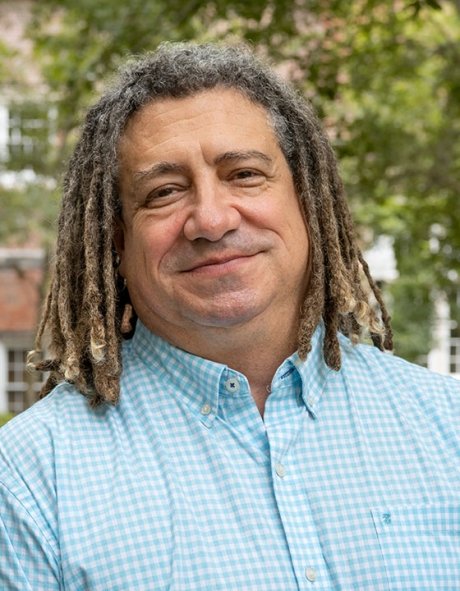Prof. Sid Dobrin Discusses Use of Artificial Intelligence in Higher Ed
- News & Events
- News
- Prof. Sid Dobrin Discusses Use of Artificial Intelligence in Higher Ed

Professor Sid Dobrin is one of the world’s most sought-after academic experts on GenAI.
GenAI – a type of artificial intelligence that can generate new content such as text, images and code in response to inputted prompts – is growing on college campuses.
Sid Dobrin, chair of the English Department at the University of Florida, is one of the foremost scholars and most sought-after academic experts on GenAI. He has delivered more than 70 talks and workshops around the world and recently testified before the U.S. House Committee on Education and Workforce about AI, GenAI and education.
The following conversation gives a snapshot of Dobrin’s thoughts:
Are you surprised by the sudden rise in the use of GenAI at colleges and universities since ChatGPT launched?
No, I’m not surprised at all. The 2022 launch of ChatGPT did startle many folks, but we have been talking about both artificial intelligence and generative artificial intelligence in education for quite a while. What sparked the accelerated conversation over the last few years was the fact that ChatGPT was released as a free platform, which put it in the hands of a lot of people. You’re talking about an application that broke all records in deployment with a million users in its first five days and more than 100 million in the first few months. So, it’s not a surprise that we’ve started talking about GenAI; what’s surprising is that we’ve had to start talking about it so fast.
You will be presenting a lecture to Rhode Island College faculty on how to inject GenAI into their pedagogy. What are some of the ways faculty can support writing development while using GenAI?
That question has both conceptual and practical matters that must be considered. If we’re going to integrate GenAI into the writing curriculum, the first question we must ask is why we are doing it. I ask that question to a lot of teachers around the world and the most common response is, “I feel like I have to because everyone else is.” But that poses a question of technological determinism. Am I changing because the technology is available? And how will it truly fulfill what I want to do?
The other caveat is that GenAI doesn’t belong in every single classroom. Just because you integrate GenAI into a writing class doesn’t mean the entire curriculum should be AI-related. You may introduce an assignment using it so that students can get their hands dirty or you may create a scaffolded curriculum where students are learning fundamental AI literacy at the beginning and by the end of the course have become more adept at the role AI plays in academic research or technical, professional or business writing.
What are some of the challenges of using GenAI in higher ed?
One of the biggest issues is what platforms, such as ChatGPT, Gemini and Co-Pilot, are you using when you integrate GenAI into a writing class, because now you open the door to questions of access, privacy and intellectual property. Teachers and institutions of higher education must look at matters of compliance. How do these platforms comply with institutional policies?
In any given week, we’re seeing anywhere from several dozen to a thousand new platforms for GenAI being released that are more disciplinary specific and education based.
Is ChatGPT the most common GenAI platform?
That depends on the institution. For example, some colleges have adopted campuswide licenses for various platforms. ChatGPT, Gemini and Co-Pilot were not designed as academic platforms. They’re generic platforms. We’re starting to see an increase in platforms that are designed for higher education and address academic integrity, such as Grammarly. I honestly don’t know which platform is the most common but certainly we know ChatGPT’s usage number is in the billions now.
Is there any significant evidence to show widespread cheating among students who use GenAI?
We know why students cheat. One reason is bad time management, and another reason is that they’re not invested in the assignment or the class. The bigger question has to do with what we mean by “cheating.” A lot of that has to do with how students are being told what they can and can’t do with GenAI in a class, which is why I spend a lot of time with teachers developing syllabi statements.
The data shows that cheating hasn’t increased since the innovation of ChatGPT and GenAI. This gives us an opportunity to rethink what we mean when we say academic integrity. We need to talk about integrity in terms of academic, professional, civic and personal integrity and what role these AI tools play in creating responsible use. How do we teach our students responsible use of these tools, just as we would for any other tool?
Most students aren’t asking GenAI to do their assignments. They’re using it to generate ideas and to clarify what they’re writing. It’s like an editorial assistant that students are using in a supplemental way.
GenAI is about augmentation not automation.
How much more immersive will GenAI become at colleges? Is this only the tip of the iceberg?
I hate to make predictions, but from my perspective, we’re at the tip of the iceberg and that iceberg must be explored.
Professor Sid Dobrin will present to RIC faculty on Wednesday, April 9, from 9-11:30 a.m., in the Faculty Center Dining Room. He will address the entire RIC community on the same day from 12-1 p.m. in Fogarty Life Science, Room 050.
